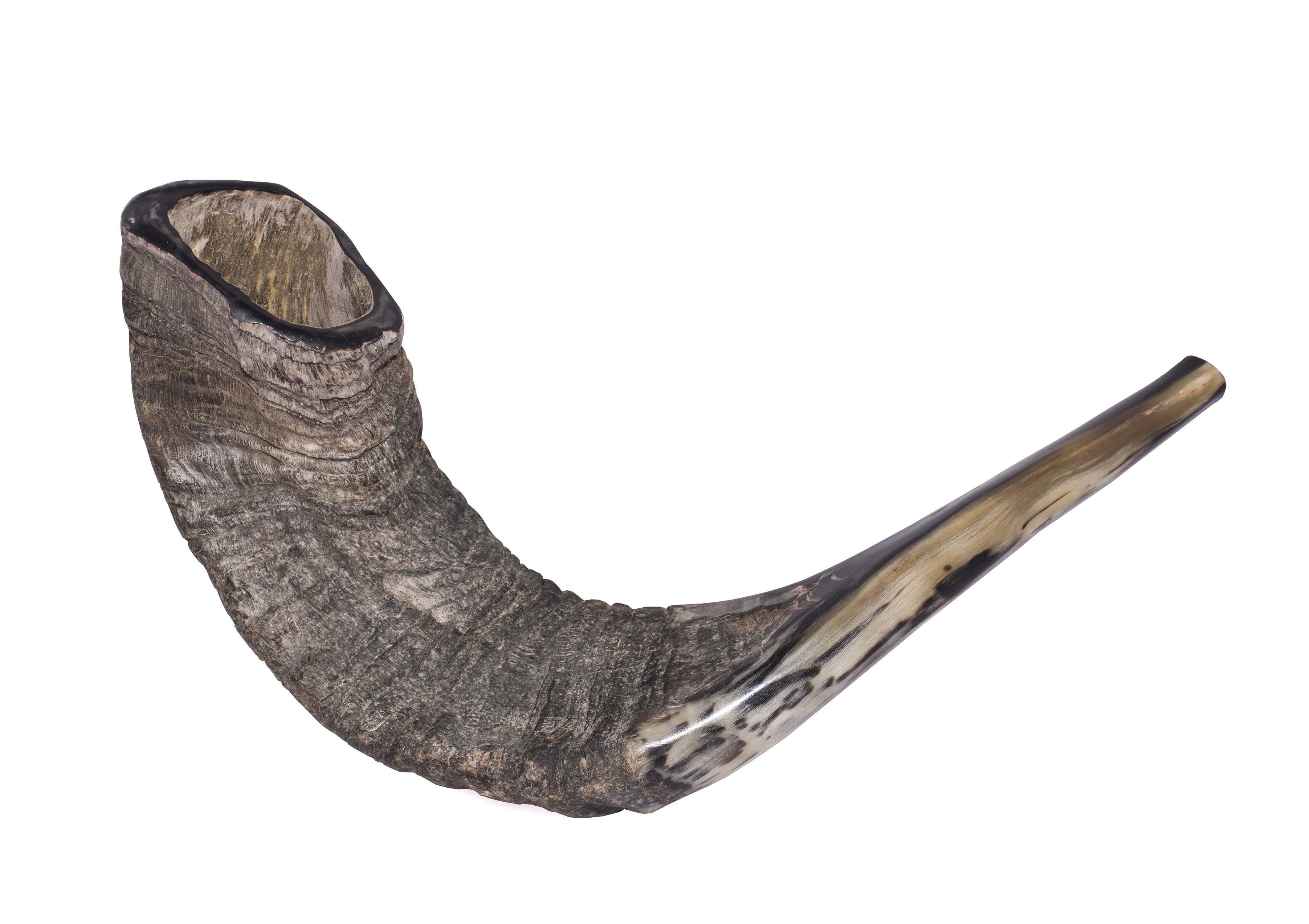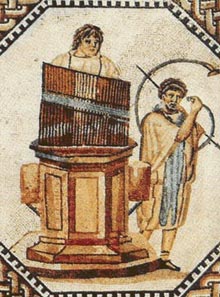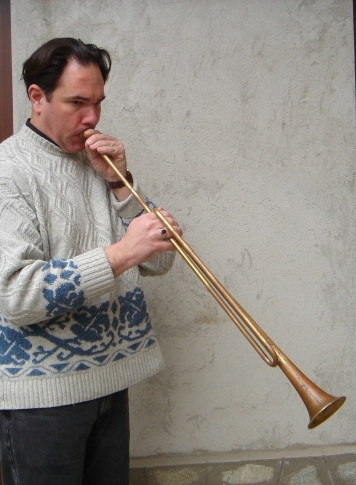|
Trumpets
The trumpet is a brass instrument commonly used in classical and jazz ensembles. The trumpet group ranges from the piccolo trumpet—with the highest register in the brass family—to the bass trumpet, pitched one octave below the standard B or C trumpet. Trumpet-like instruments have historically been used as signaling devices in battle or hunting, with examples dating back to the 2nd Millenium BC. They began to be used as musical instruments only in the late 14th or early 15th century. Trumpets are used in art music styles, appearing in orchestras, concert bands, chamber music groups, and jazz ensembles. They are also common in popular music and are generally included in school bands. Sound is produced by vibrating the lips in a mouthpiece, which starts a standing wave in the air column of the instrument. Since the late 15th century, trumpets have primarily been constructed of brass tubing, usually bent twice into a rounded rectangular shape. There are many distinct typ ... [...More Info...] [...Related Items...] OR: [Wikipedia] [Google] [Baidu] |
Natural Trumpet
A natural trumpet is a valveless brass instrument that is able to play the notes of the harmonic series. History :''See: Clarion'' The natural trumpet was used as a military instrument to facilitate communication (e.g. break camp, retreat, etc.). Even before the late Baroque period the natural trumpet had been accepted into Western art music. There is evidence, for example, of extensive use of trumpet ensembles in Venetian ceremonial music of the 16th century. Although neither Andrea nor Giovanni Gabrieli wrote music specifically for the trumpet, they would have been very familiar with its technical possibilities. Later, talented players such as the early baroque composer Girolamo Fantini demonstrated that by playing in the extreme upper register and "lipping" the notes of the 11th and 13th harmonics (that is, flattening or sharpening those impure harmonics into tune with the embouchure), it was possible to play diatonic major and minor scales (and, hence, actual melodie ... [...More Info...] [...Related Items...] OR: [Wikipedia] [Google] [Baidu] |
Bugle (instrument)
The bugle is a simple signaling brass instrument with a wide conical bore. It normally has no valves or other pitch-altering devices, and is thus limited to its natural harmonic notes, and pitch is controlled entirely by varying the air and embouchure. History :''See also Clarion'' and '' Natural trumpet'' The English word ''bugle'' comes from a combination of words. From French, it reaches back to ''cor buglèr'' and ''bugleret'', indicating a signaling horn made from a small cow's horn. Going back further, it touches on Latin, ''buculus,'' meaning bullock. Old English also influences the modern word with ''bugle'', meaning "wild ox." The name indicates an animal's (cow's) horn, which was the way horns were made in Europe after the fall of the Western Roman Empire. The modern bugle is made from metal tubing, and that technology has roots which date back to the Roman Empire, as well as to the Middle East during the Crusades, where Europeans re-discovered metal-tube ... [...More Info...] [...Related Items...] OR: [Wikipedia] [Google] [Baidu] |
Brass Instrument
A brass instrument is a musical instrument that produces sound by Sympathetic resonance, sympathetic vibration of air in a tubular resonator in sympathy with the vibration of the player's lips. The term ''labrosone'', from Latin elements meaning "lip" and "sound", is also used for the group, since instruments employing this "lip reed" method of sound production can be made from other materials like wood or animal horn, particularly early or traditional instruments such as the cornett, alphorn or shofar. There are several factors involved in producing different Pitch of brass instruments, pitches on a brass instrument. Slide (wind instrument), Slides, Brass instrument valve, valves, Crook (music), crooks (though they are rarely used today), or Key (instrument), keys are used to change vibratory length of tubing, thus changing the available harmonic series (music), harmonic series, while the player's embouchure, lip tension and air flow serve to select the specific harmonic produ ... [...More Info...] [...Related Items...] OR: [Wikipedia] [Google] [Baidu] |
Shofar
A shofar ( ; from , ) is an ancient musical horn, typically a ram's horn, used for Jewish ritual purposes. Like the modern bugle, the shofar lacks pitch-altering devices, with all pitch control done by varying the player's embouchure. The shofar is blown in synagogue services on Rosh Hashanah and at the end of Yom Kippur; it is also blown every weekday morning in the month of Elul running up to Rosh Hashanah. Shofars come in a variety of sizes and shapes, depending on the choice of animal and level of finish. Bible and rabbinic literature The shofar is mentioned frequently in the Hebrew Bible, the Talmud and rabbinic literature. In the first instance, in , the blast of a shofar emanating from the thick cloud on Mount Sinai makes the Israelites tremble in awe. The shofar was used to announce the new moon and the Jubilee year. The first day of Tishrei (now known as Rosh Hashana) is termed a "memorial of blowing", or "day of blowing", the shofar. Shofars were used for si ... [...More Info...] [...Related Items...] OR: [Wikipedia] [Google] [Baidu] |
Cornet
The cornet (, ) is a brass instrument similar to the trumpet but distinguished from it by its conical bore, more compact shape, and mellower tone quality. The most common cornet is a transposing instrument in B. There is also a soprano cornet in E and cornets in A and C. All are unrelated to the Renaissance and early Baroque cornett. History The cornet was derived from the posthorn by applying valves to it in the 1820s. Initially using Stölzel valves, by the 1830s, Parisian makers were using the improved Périnet piston valves. Cornets first appeared as separate instrumental parts in 19th-century French compositions.''Encyclopædia Britannica'', Micropedia, Volume III, William Benton, Chicago Illinois, 1974, p. 156 The instrument could not have been developed without the improvement of piston valves by Silesian horn players Friedrich Blühmel (or Blümel) and Heinrich Stölzel, in the early 19th century. These two instrument makers almost simultaneously invented valv ... [...More Info...] [...Related Items...] OR: [Wikipedia] [Google] [Baidu] |
Horn (instrument)
A horn is any of a family of musical instruments made of a tube, usually made of metal and often curved in various ways, with one narrow end into which the musician blows, and a wide end from which sound emerges. In horns, unlike some other brass instruments such as the trumpet, the bore gradually increases in width through most of its length—that is to say, it is conical rather than cylindrical. In jazz and popular-music contexts, the word may be used loosely to refer to any wind instrument, and a section of brass or woodwind instruments, or a mixture of the two, is called a horn section in these contexts. Types Variations include: * Lur (prehistoric) * Shofar * Alboka *Roman horns: ** Cornu ** Buccina * Dung chen * Dord * Sringa * Nyele * Wazza * Waqra phuku * Alphorn *Cornett * Serpent * Ophicleide * Natural horn ** Bugle ** Post horn *French horn * German horn * Vienna horn * Wagner tuba * Saxhorns, including: ** Alto horn (UK: tenor horn), pitched in E ** Baritone ho ... [...More Info...] [...Related Items...] OR: [Wikipedia] [Google] [Baidu] |
Piccolo Trumpet
The piccolo trumpet is the smallest member of the trumpet family, pitched one octave higher than the standard B trumpet. Most piccolo trumpets are built to play in either B or A, using a separate leadpipe for each key. The tubing in the B piccolo trumpet is one-half the length of that in a standard B trumpet. Piccolo trumpets in G, F, and even high C are also manufactured, but are rarer. The piccolo trumpet should not be confused with the pocket trumpet, which plays in the same pitch as the regular B trumpet. Types and details The piccolo trumpet in B is a transposing instrument, which sounds a minor seventh higher than written. Not often called for specifically, it is often used at the player's discretion to cover high material as appropriate. The piccolo trumpet in D, also known as the ''Bach trumpet'', was invented and first used in the late 19th century by the Belgian instrument maker Victor Mahillon to play the high trumpet parts in music by Johann Sebastian Bach, Bach ... [...More Info...] [...Related Items...] OR: [Wikipedia] [Google] [Baidu] |
Bass Trumpet
The bass trumpet is a type of low trumpet which was first developed during the 1820s in Germany. It is usually pitched in 8' C or 9' B today, but is sometimes built in E and is treated as a transposing instrument sounding either an octave, a sixth or a ninth lower than written, depending on the pitch of the instrument. Having valves and the same tubing length, the bass trumpet is quite similar to the valve trombone, although the bass trumpet has a harder, more metallic tone. Certain modern manufacturers that sell 'valve trombones' and 'bass trumpets' employ the same tubing, valves, and bell in different combinations; in these circumstances, the bass trumpet is nearly similar to the valve trombone. History The earliest mention of the bass trumpet is in the 1821 ''Allgemeine Musikalische Zeitung'', in which Heinrich Stölzel's ''Chromatische Tenor-Trompetenbaß'' and Griesling & Schlott's ''Chromatische Trompetenbaß'' are described. Several other variants were produced through th ... [...More Info...] [...Related Items...] OR: [Wikipedia] [Google] [Baidu] |
Cornu (horn)
A ''cornu'' or ''cornum'' (, " horn", sometimes translated misleadingly as " cornet"; : ''cornua'') was an ancient Roman brass instrument about long in the shape of a letter 'G'. The instrument was braced by a crossbar that stiffened the structure and provided a means of supporting its weight on the player's shoulder. Some specimens survive in the archaeological record, two from the ruins of Pompeii. The ''cornu'' may be difficult to distinguish from the '' buccina''. It was used by the Roman army for communicating orders to troops in battle. In Roman art, the ''cornu'' appears among the instruments that accompany games ''( ludi)'' or gladiator combat in the arena, as on the Zliten mosaic. History and usage It was invented by the Etruscans for use in their funeral processions and military. Roman artistic representations of the ''cornu'' are typically realistic. While Etruscan art usually depict the ''cornu'' in use alongside the lituus. It was likely a status symbol ... [...More Info...] [...Related Items...] OR: [Wikipedia] [Google] [Baidu] |
Slide Trumpet
The slide trumpet is an early type of trumpet fitted with a movable section of telescopic tubing, similar to the slide of a trombone. Eventually, the slide trumpet evolved into the sackbut, which evolved into the modern-day trombone. The key difference between these two instruments is that the slide trumpet possesses only a ''single'' slide joint, rather than the two joints in the U-shaped slide of the sackbut or trombone. There are several types of slide trumpet of different places and eras. Early instrument The slide trumpet grew out of the war trumpet as used and developed in Western and Central Europe: Don Smithers argues that the slide grew out of the detachable leadpipe, and separated the use of the trumpet as a dance instrument from the trumpet as a signaling device in war. Renaissance slide trumpet :''See: Clarion'' As no instruments from this period are known to have survived, the details—and even the existence—of a Renaissance slide trumpet is a matter of some ... [...More Info...] [...Related Items...] OR: [Wikipedia] [Google] [Baidu] |
Pocket Trumpet
250px, Pocket trumpet in B-flat, with a standard size bell and medium-large bore The pocket trumpet is a B♭ or C trumpet that is constructed with the tubing wound into a much smaller coil than a standard trumpet, generally with a smaller diameter bell. It is not a standard instrument in a concert band or orchestra and is generally regarded as a novelty. It has been used by soloists in jazz ( Don Cherry played the similar pocket cornet) or other ensembles to add flair and variety. History The concept of reducing the brass instrument size without reducing the resonating tube length can be seen in several 19th century models of cornet. ''Pocket cornets'' have been constructed since the 1870s. Pocket trumpets are sometimes played as auxiliary instruments by soloists in jazz and dixieland bands, as well as for some specific studio recording demands. Don Cherry's work with the Ornette Coleman quartet is probably the best known example of pocket trumpet playing. Design and prop ... [...More Info...] [...Related Items...] OR: [Wikipedia] [Google] [Baidu] |







